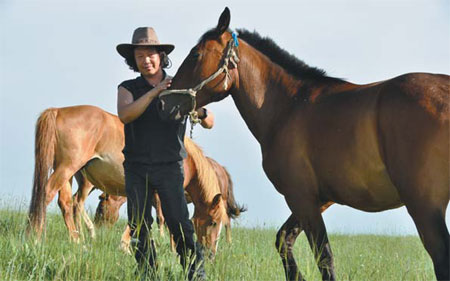Though known for horses, painter has broader range
|
Horses and grasslands helped shape Qi Hong's view of art. Provided to China Daily |
Not all paintings of galloping horses are the same.
The works of Qi Hong, a Chinese painter who grew up on horseback, have more to say with their distinctive combination of Eastern and Western styles.
Qi, now an artist-in-residence at the Singapore Nanyang Arts House, is a master in Chinese ink, murals and oil paintings.
He is particularly skilled at painting horses, and his work has won him renown throughout China, France, Japan and Southeast Asia.
In September 2013, Qi was the only Chinese artist to be invited to hold a solo exhibition - "A Galloping Horse: Qi Hong Ink Paintings Exhibition" - for the 2013 Singapore President's Challenge, a charity campaign run by the government.
In 2011, his series of horse paintings Galloping Against the Skyline was first introduced to Singapore.
The series won instant acclaim. Many of the works have been acquired by collectors from Indonesia, Malaysia and Singapore.
All theses achievements are hard won. Born to a family of farmers in Liaoning province, Qi has come a long way in the world of art.
"My family owned a carriage, so in my childhood, I cut hay, cleaned manure, and fed and brushed horses everyday," Qi said. "That carriage was the only source of income for my family."
This experience was an inspiration for Qi as well.
"The horses fascinated me. I stared at them, and then used stones to draw pictures of them on the ground," he said.
"The carriage triggered my interest in painting. So when I grew older, I used pens to illustrate the very strong and handsome features of horses."
In 1983, Qi was accepted by the Shenyang Lu Xun Academy of Fine Arts, where he studied horse painting from Xu Yong.
"Xu Yong's horse paintings are lifelike, diverse, novel and full of energy," Qi said. "And through his teachings, I learned how to capture not only a horse's appearance but also its essence."
Qi graduated from China Central Academy of Fine Arts, where he majored in mural painting.
In 2013, with his achievements in painting, Qi was accepted by the graduate school of Peking University, studying and doing research with Liu Dawei in Liu's studio. Liu is also a master in Chinese painting.
Through years of training and practice, Qi developed his own style of horse painting, which has won him renown throughout the world.
His extemporaneous Chinese ink painting The Vigor of the Horse, measuring 14.2 by 7.3 meters, set a new record in the Singapore Book of Records for the Largest Chinese Brush Painting at the Bras Basah Complex.
"Qi's horses, painted in ink, are unique. He merges Xu Beihong's accuracy with Ma Ende's magnificence," deputy editor-in-chief of Art Magazine Chen Jianming said. "They have power from the inside out."
"We have a lot of horse painters, but his painting has some modern elements, and it's different from others," said Liang Zhenkang, president of the Federation of Art Societies Singapore
"Painters in the past tended to illustrate horses in an externalized way. Qi doesn't," said Liang.
Qi said painters needed to develop their own styles instead of simply sticking on the old rules.
"Take horse painting as an example. People today won't accept it if it is too old-school," said he. "Therefore my painting is a mixture of modern and traditional elements as well as independent thinking."
In addition to horse painting, Qi is also a master of mural and oil painting.
In 1996, he started to compose a classic mural painting Daoism: Pilgrimage of the Celestials, which is 4.26 meters high and 14.5 meters long.
The painting includes 286 deities and is viewed as a world-class work of art, Chen said.
In order to complete this massive project, Qi researched in the Chinese Academy of Social Sciences and worked with scholars of literature and history from Shanxi province.
This piece of work contributed to an even larger-scale project Yongle Temple Mural Painting, which is now collected by a Japanese collector.
Besides, he also contributed to the composition of another mural pianting project Water, Moon and Guanyin, which is owned by an institution in Singapore.
Qi's oil paintings have also won a number of honors and awards nationwide. Some of them are exhibited and collected by museums.
He is bold and innovative. "No matter what types of art he tries, he can always turn it into a unique and special one," said Chen.
zhuanti@chinadaily.com.cn



















